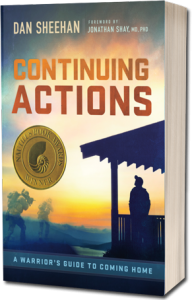Continuing Actions Chapter 2
DEADLY MISCONCEPTIONS
MECHANICAL ADJUSTMENTS are easy. If a pistol-shooter consistently hits low on the target, it’s more than likely they’re anticipating the shot. A good pistol coach can break that bad habit and have them drilling the bull’s-eye in short order. The same cannot be said for mental adjustments.
Mental adjustments cannot be externally imposed—they have to come from within. In order for us to change how we perceive the world, we need some motivation, some personal understanding of why the adjustment is necessary. Years of inertia must be overcome before most people will even listen to a different viewpoint, let alone change theirs. This is certainly the case when it comes to veterans’ expectations of how they should be able to return from combat. Based in wishful thinking, these comforting fairy tales encourage stagnation and are among the first of the obstacles veterans must face when they come home. They were for me.
Like many veterans, I figured that I should be able to just move on after I came home from Iraq. When it became obvious that I couldn’t, my first reaction wasn’t to ask for help. I didn’t look inward for clues to what was bothering me or even consider trying to figure out how my experiences had impacted me. No, my first reaction was denial.
This isn’t happening to me. No way, not this guy.
My reaction was not unique. As Americans, we’re bombarded by examples of fictional heroes “strong enough” to remain unaffected by the carnage and mayhem around them. Consciously or not, these images shape our expectations that we, as real warriors, should be strong enough to be unaffected as well. But after we get home, and the evidence mounts that something actually is bothering us, we feel betrayed by some personal shortcoming we never knew existed. Because our misconceptions tell us those reactions are symptoms of weakness, we put all our efforts into hiding them—and stagnate on our journey as a result.
The assumptions I’d made—well before actually going to war—about how I should be able to come home gave me only one choice: Ignore the pain and unease or admit to being a weakling. There was no other option. My misconceptions told me I should be able to move on with my life like previous generations, that my experiences were nowhere near as traumatic as other veterans’, and that nothing I’d been through rated feeling the slightest unease. It was only after examining these misconceptions that I saw how they’d trapped me—and continue to trap millions of others.
FINDING THE POO (POINT OF ORIGIN)
Challenging these misconceptions is an obstacle that keeps many of us from ever moving forward after combat. Instead, we build walls of denial that keep even the bravest from ever leaving the safety of our mental Forward Operating Bases (FOBs). Barricaded behind HESCOs filled with assumptions and hearsay, men and women who’ve demonstrated tremendous courage in the past meekly accept indirect fire attacks as thoughts of “I’m a puss,” “I should be strong enough to ignore this,” and “What’s wrong with me?” impact all around them. Although they have the power to do so, they never go outside the wire to hunt down and kill the misconceptions launching these thoughts. Instead, they accept the limitations of life under a state of perpetual siege.
A series of events in my own life—my brother’s near fatal helicopter crash, the responsibilities of fatherhood, and my wife’s refusal to allow me to stagnate—prompted me to abandon the walls of denial that had formed my FOB. I might have dug in even deeper, though, built my walls higher and hidden behind thicker barriers, if it hadn’t been for the confusion those events generated within me. My overreaction to the news of my brother’s crash, fear of passing my burdens on to my children, and the widening gap between my wife and me forced me to make a decision— barricade forever or take action. It somehow felt cowardly to sit behind a barricade, so, five years after coming home, I decided to get off my ass. The mission that followed hasn’t been easy, but it’s been worth it. By leaving the supposed safety of denial, I was finally able to locate, close with, and destroy the misconceptions that had been making me feel like a weakling.
These misconceptions are common among veterans, so dragging them into the open and examining them is a worthwhile exercise. To start with, let’s take a closer look at why, with a stack of medals on my chest and two combat tours under my belt, I believed my right to call myself a warrior was so tenuous that it could be erased if I admitted feeling any aftereffects from what I’d been through.
THE GREATEST GENERATION
“It is historically typical for returning American war veterans throughout our history to be ignored by the communities they returned to, rather than to be celebrated and cherished by them. The expe- rience of the World War II veterans—the fathers of the Vietnam veterans—is the historical anomaly.” —Jonathan Shay, Odysseus in America p.154
Of all the conflicts in our nation’s history, the one I figured least likely to cause lasting aftereffects among our veterans was World War II (WWII). Wasn’t that the “good war?” Weren’t the lines of good and evil clearly drawn and obvious? Didn’t the entire nation mobilize for the common good of the world? And after the ticker-tape stopped falling, didn’t everyone buy a new Chevy, impregnate his wife, go to college, and build postwar America into a superpower? From everything I’d absorbed from movies and books about the veterans of WWII, it seemed like, while some had suffered horrible wounds, they returned generally healthy, emotionally whole, and moved onward in their lives without a hitch. This rosy view of the WWII veteran experience formed my expectations of what I, with my relatively short durations of combat in Iraq, should be able to do when I got home. If those guys could endure the horrors of Guadalcanal and Iwo Jima and be fine, then I sure as hell should be able to do the same after An Nasiriyah. They set the bar high but I figured I was tough enough to reach it.
Then I read Thomas Childers’ Soldier from the War Returning and realized my perceptions were based in fantasy, selective memory, and Hollywood fairy dust. In his prologue, the University of Pennsylvania history professor attacks the “blanket of nostalgic adulation” Americans have used to
“muffle . . . the complex, often painful realities of their postwar experiences . . . the most prominent expression of which is found in Tom Brokaw’s best-selling book The Greatest Generation. This glowing homage has become more than a tribute to a passing generation; it has become our public memory of the war and its aftermath, a quasi-official transcript of events that glides sentimentally over what for many veterans was a deeply troubled reentry into a civilian world that, like themselves, had undergone dramatic change.” (Childers, p.4)
And what characterized the “deeply troubled reentry” Childers mentions?
“. . . unemployment among veterans was rampant— triple that of civilians in 1947. Housing was also hard to find. . . . In early 1946, an estimated 1.5 million veterans were living with friends or family, and in some cities as many as one-third of all married veterans were living with a friend or relative.” (Childers, p.7)
And those were just the material challenges of coming home. What about the psychological ones? Again, my rose-colored glasses had given me the false impression that the noble aspects of WWII had protected its veterans from postcombat adjustment challenges.
“Post-traumatic stress disorder was not diagnosed until 1980, but in the aftermath of the Second World War, depression, recurring nightmares, survivor guilt, outbursts of rage (most frequently directed at family members), “exaggerated startle responses,” and anxiety reactions—all of which are recognized today as classic symptoms of PTSD—were as common as they were unnerving.” (Childers, p.8)
Professor Childers rounded out my education when he tied the unaddressed emotional aftereffects of WWII veterans to those suffered by veterans of other wars:
“It is time to confront the emotional aftershocks of the Second World War, not just for aging veterans, many of whom are turning up in VA hospitals with undiagnosed chronic or delayed-onset PTSD, but also for a new generation of men and women struggling to adjust to a life interrupted and forever changed by war. . . .
Long consigned to a dim corner of our public memory, many of the same deeply disturbing social and personal problems arising from the wars in Vietnam, Iraq, and Afghanistan were glaringly present in the aftermath of the Second World War.” (Childers, p.13)
The veterans of World War II did fight bravely amid terrible circumstances. And they also helped America become the strongest nation on earth after they came home. But they did not do it without inner torment, ruined marriages, and incredible personal burdens that became family legacies of pain. They hid their pain because that’s what they were expected to do—and lived forever in its clutches.
COMPARING APPLES TO ORANGES
The second misconception I faced stemmed from my habit of measuring my experiences against other people’s. I imagined the experiences of combat spread along a static gradation of trauma. On one end might be stubbing your toe, and on the other, the Bataan Death March. Because I never examined it closely, this assumption imposed an artificial measurement of the relative trauma I felt I should have experienced based on where my experiences fell on the spectrum. I hadn’t stormed the beach in Normandy, hadn’t slithered through tunnels in Cu Chi, or held a friend’s head as he died. My experiences were somewhere above a stubbed toe but certainly not bad enough to rate aftereffects.
Yet there they were.
And the fact that I couldn’t just ignore the aftereffects, couldn’t just suppress the unease and make it go away, called into question my own fortitude. If other veterans have been through much tougher situations and seem fine, then what the hell is wrong with me? Renowned psychiatrist Jonathan Shay describes this reaction as creating “hierarchies of suffering” and labels it one of the major impediments to healing that combat veterans impose on themselves. This common misconception, based in making comparisons, is hard to ignore because the supposed evidence is right there—he served three tours while I only served two; she got shot and I never did; he patrolled Lashkar Gah while I just flew over Baghdad . . .
A former squadron mate of my father unwittingly (?) rein- forced this misconception in his review of my book, After Action, on Amazon. In it he stated, “The author dealt with many issues we former veterans didn’t seem to like to talk about, but I was very taken aback by how affected these young men were following only a few weeks of combat.” This Vietnam veteran seems to have assumed, like I used to, that you could apply objective metrics like time and intensity of events to an experience like combat and come up with a threshold that would determine aftereffects—below it you’re fine, above it you’re a mess. There’s a fair amount of bravado mixed in here as well, a feeling that “We had it much tougher and turned out fine—what’s wrong with you?” that gave his comment added sting.
But you can’t measure the impact of experiences like that. Does it matter if a person is exposed to one second or ten years in combat? Not to that person. What matters is the impact that person’s experiences had on them—and that cannot be measured solely by duration or even by their intense or dramatic nature. What I experience inwardly in a given situation can be very different from the impact that same event has on you, the person standing next to me. My personal experience and yours are that unique.
The urge to downplay our own experiences is deeply ingrained in our warrior ethos. We all know men and women who’ve done incredible things yet remain humble about their accomplishments. This humbleness enhances their status in our eyes and is an attribute that is worthy of emulation. But it is not humility that inhibits us from honestly examining how our experiences have affected us. It is fear.
We fear that some imaginary council of ultimate warriors will apply the same false calculus to our experiences and decide, once and for all, that we are weak. We fear that our comrades will somehow think less of us, that our right to call ourselves warriors will be revoked, or that we’ll forfeit the respect we would have enjoyed if we’d just been strong enough to keep telling ourselves that others had it tougher and are fine.
I hope I’ve made this misconception sound childish because, well, it is. That doesn’t mean it will be easy to overcome, though. Just remember, when it comes to determining what events hold the power to destroy your life long after they’re over, only your internal experiences matter. Fear of what somebody else might, or might not, think? C’mon, we left junior high school a long time ago.
A SKILL HALF-TAUGHT
The third misconception I had to overcome was the most insidious. It stemmed from the very efficiency of the training I had received and highlights a primary shortcoming in how we perceive the challenges of being a warrior.
Long before I ever imagined I would become a pilot, flying was a part of my life. My father was a Navy pilot, like his father before him, and my early memories are studded with old airplanes, air shows, and airports. Seizing an opportunity to educate my brother and sister and me, Dad named our first four or five parakeets “Bernoulli” after the Swiss mathematician who explained how a wing creates lift. It was years before I stopped trying to look under the wings of passing planes to see the little brightly colored birds pushing it up in the sky.
I was slightly less clueless when I reported to flight school as a Marine Second Lieutenant years later, but it didn’t matter. The instructors assumed I had never seen an aircraft and started from the ground up. The training covered every possible contingency and was so thorough I’m convinced they could have taught a monkey how to fly.
This same scenario was repeated multiple times throughout my military training. Instructors always assumed I knew nothing, and every challenge I was expected to encounter was identified and clearly explained to me. Only after I understood every aspect of the challenge was I given concrete instructions for overcoming it. And I wasn’t trained to deal only with physical challenges, but with mental ones as well.
But the preparation I received for the mental challenges of combat did not follow the normal template of military training. Instead of exhaustively explaining these challenges and then dictating thorough steps to overcome them, this training was informal and hodgepodge. In fact, the entirety of my preparation for the mental challenges of combat consisted of honing just one skill—compartmentalization.
I was expected to take anything that could potentially distract me and ignore it. A fender-bender on the way to work? Stuff it away before climbing in the cockpit. Break up with, or knock up, my girlfriend? Don’t think about it while flying. Bullets cracking past the cockpit or a buddy’s bird crashing in flames? Drive on and accomplish the mission. From the mundane to the extreme, I was taught that emotions and reactions were dangerous distractors that could get me or my comrades killed—or worse, fail to complete our mission.
Compartmentalization was my mental flak jacket. It protected me from emotional reactions and allowed my other training to guide me through the physical challenges that were generating them. Focus on the mission, stuff anything uncomfortable or painful away, and drive on. As essential as this was for survival in combat, there was something vital missing from what I’d been taught of compartmentalization.
You can’t do it forever.
You see, compartmentalization is a short-term solution— kind of like a tourniquet. When applied during an emergency, there is a good chance it will save your life. But nobody walks around with a tourniquet for any longer than it takes to get to a hospital. It hurts, you can’t use the appendage, and there’s a good chance that it is destroying parts of you while saving your life. No, you get to medical attention and they remove the tourniquet as soon as safely possible.
James Wright, author of Those Who Have Borne the Battle, highlights the destructive effects of keeping this mental tourniquet on too long. In this book, he quotes Bobby Muller, a paralyzed Vietnam veteran and organizer of Vietnam Veterans of America, in 1979:
“. . . Muller told a reporter that while going to war was traditionally a defining experience in anyone’s life, Vietnam veterans had learned to keep quiet about it. He said that “we came home and were told we were either fools or killers. Guys came home after this significant life experience and they’ve never had the opportunity to talk about it. It’s torn people apart. It’s unnatural.””(Wright, p.207)
Somehow this lesson never made it into my instructors’ training manuals. The requirement to take the mental tourniquet off—to de-compartmentalize—was never even hinted at in any of my training. It was simply never discussed, like it didn’t exist. So when my unease followed me home from Iraq, when caustic emotions from my past started to seep into my present, I was worse than unprepared. My “go-to” move, what I’d been taught and had used effectively in the past, turned out to be exactly the wrong thing to do.
Without recognizing the dangers, I doubled down on compartmentalization. I ignored the signs that something was bothering me, that I was reacting differently and was uncomfortable in my own skin. I assumed these were symptoms of some latent weakness that was just now, after two combat tours, making itself known. I didn’t recognize them as unavoidable reactions to continued compartmentalization, and it didn’t even cross my mind to take that tourniquet off. Instead, I redoubled my efforts to hide the unease, to bury it away like I had in combat. Angrily, I berated myself for being so weak as to let it show at all.
This is the misconception that is the hardest to overcome. We trust that our training thoroughly prepared us for every challenge we were expected to encounter. Why? Because for the most part it did. So if we encounter a challenge we weren’t prepared for, we don’t assume it was overlooked. Rather, we assume the fault lies with us, that we should be able to overcome it with what we had been taught.
As a result, most of us just try to stuff the memories and emotions of combat away when we come home. Then, when they inject rage, terror, guilt, and fear into our daily lives, we get mad at ourselves for failing to keep them under wraps before stuffing them away again. But this just reprimes the pump and ensures the suppressed emotions will escape again later on. By teaching only one skill, one defense mechanism against the mental rigors of being a warrior, our training set us up for success in combat but failure at home.
These failures don’t have to be extreme. You don’t have to snort your paycheck up your nose for months on end, ride your motorcycle at 120mph on the highway, or fight everybody who looks crossways at you to fail at coming home. Those sorts of catastrophes make for compelling stories, but they are not indicative of most veterans’ experiences. Most veterans come home and put genuine effort into moving forward in life, focusing on their family, and being productive members of society. Does it matter if his children don’t know him very well? Or if she buries herself in work because it’s the only time she doesn’t have to be reminded of the past? Why should we be concerned when our families excuse our behavior with an embarrassed, “We don’t know—he was just never the same after the war”? Or stop having beer or wine in the house when we come to visit because our mood swings are too unpredictable after a few drinks? These, and many other indicators that we have not come to grips with our experiences, erode us quietly from within. They may not be dramatic failures worthy of the evening news, but they can screw up our lives nonetheless.
IN THE ABSENCE OF ORDERS . . .
We have come a long way from the days when knights provided their own weapons and horses when they went to fight. Today, a compact exists between the citizen who volunteers to serve and the nation that benefits from their service: We’ll provide the training and tools, you provide the blood, sweat, courage, and commitment to get the job done. And Americans have gotten the job done over and over again. But, as we’ve discovered, just getting the job done overseas is not the end of the warrior’s journey. There is a long road to be traveled afterward that is not covered by a modern warrior’s training. This training is sufficient to get us into combat and emerge victorious, but not to return home.
There’s no conspiracy here, no dark force bent on creating a class of warriors capable of fighting and nothing else. The reason modern warriors are not prepared for the challenges of coming home is simple: These are individual challenges, and the means to overcome them will vary with each individual. Military training is not known for enhancing individuality, or the skills required for introspection, and those who exhibit those traits while in the military are “encouraged” to hide them. Over time, they wither away from disuse. Ironically, those are the very traits and skills a warrior needs in order to process, learn, and grow from his experiences.
To continue progressing along the warrior’s journey, a modern warrior has to move past the belt-fed, Ooh-Rah, yut-yut mentality of just following orders—because eventually there are no orders. Outside the military there is nobody providing clear guidance for what to do and how to do it. No external power can impose measures designed to usher you into the final stage of the warrior’s journey. You have to do it yourself. You have to become your own pistol coach, identify where your rounds are hitting, and then figure out what adjustments to make to get them into the black.
The first thing you’ll have to do is seize the initiative. In the absence of orders, you have to choose to face the challenges before you, choose to patrol outside your wire, and choose to challenge the assumptions holding you hostage. But you can’t just start firing from the hip—you need to have a plan.
Nobody likes mission planning. It’s a pain in the ass and gets in the way of all the fun stuff like working out, shooting, and jumping out of planes. But it’s essential if the mission is to be a success.
The next three chapters might feel like mission planning, but rest assured, they’re essential if you are to overcome the chal- lenges ahead. So, eat your spinach, take your vitamins, do your PME—all the crap we don’t want to do but must in order to be ready for the trials to come—and keep reading.
Don’t worry. Eventually you get to jump out of the plane.



